NCERT Answers for Class 7 Maths
Chapter 2 Fractions and Decimals Exercise 2.2
|
Chapter 2 Exercise 2.1 |
Page 36-37
Ex 2.2 Class 7 Maths Question 1. Which of the drawings (a) to (d) show:
Answer
(i) 2 × (1/5) represents the addition of 2 figures, each represents 1 shaded part out of the given 5 equal parts. Therefore 2 × (1/5) is represented by fig (d).
(ii) 2 × ½ represents the addition of 2 figures, each represents 1 shaded part out of the given 2 equal parts. Therefore 2 × ½ is represented by fig (b).
(iii) 3 × (2/3) represents the addition of 3 figures, each represents 2 shaded part out of the given 3 equal parts. Therefore 3 × (2/3) is represented by fig (a).
(iii) 3 × ¼ represents the addition of 3 figures, each represents 1 shaded part out of the given 4 equal parts. Therefore 3 × ¼ is represented by fig (c).
Ex 2.2 Class 7 Maths Question 2. Some pictures (a) to (c) are given below. Tell which of them show:
Answer
(i) 3 × (1/5) represents the addition of 3 figures, each represents 1 shaded part out of the given 5 equal parts and (3/5) represents 3 shaded parts out of 5 equal parts.
Therefore 3 × (1/5) = (3/5) is represented by fig (c).
(ii) 2 × (1/3) represents the addition of 2 figures, each represents 1 shaded part out of the given 3 equal parts and (2/3) represents 2 shaded parts out of 3 equal parts.
Therefore 2 × (1/3) = (2/3) is represented by fig (a).
(iii) 3 × (3/4) represents the addition of 3 figures, each represents 3 shaded part out of the given 4 equal parts and 2 ¼ represents 2 fully and 1 figure having 1 part as shaded out of 4 equal parts.
Therefore 3 × (3/4) = 2 ¼ is represented by fig (b).
Ex 2.2 Class 7 Maths Question 3. Multiply and reduce to lowest form and convert into a mixed fraction:
Answer
By the rule Multiplication of fraction,
Product of fraction = (product of numerator)/ (product of denominator)
Then,
= (7/1) × (3/5)
= (7 × 3)/ (1 × 5)
= (21/5)
=
(ii) 4 × (1/3)
Solution:-
By the rule Multiplication of fraction,
Product of fraction = (product of numerator)/ (product of denominator)
Then,
= (4/1) × (1/3)
= (4 × 1)/ (1 × 3)
= (4/3)
=
(iii) 2 × (6/7)
Solution:-
By the rule Multiplication of fraction,
Product of fraction = (product of numerator)/ (product of denominator)
Then,
= (2/1) × (6/7)
= (2 × 6)/ (1 × 7)
= (12/7)
=
(iv) 5 × (2/9)
Solution:-
By the rule Multiplication of fraction,
Product of fraction = (product of numerator)/ (product of denominator)
Then,
= (5/1) × (2/9)
= (5 × 2)/ (1 × 9)
= (10/9)
=
(v) (2/3) × 4
Solution:-
By the rule Multiplication of fraction,
Product of fraction = (product of numerator)/ (product of denominator)
Then,
= (2/3) × (4/1)
= (2 × 4)/ (3 × 1)
= (8/3)
=
(vi) (5/2) × 6
Solution:-
By the rule Multiplication of fraction,
Product of fraction = (product of numerator)/ (product of denominator)
Then,
= (5/2) × (6/1)
= (5 × 6)/ (2 × 1)
= (30/2)
= 15
(vii) 11 × (4/7)
Solution:-
By the rule Multiplication of fraction,
Product of fraction = (product of numerator)/ (product of denominator)
Then,
= (11/1) × (4/7)
= (11 × 4)/ (1 × 7)
= (44/7)
=
(viii) 20 × (4/5)
Solution:-
By the rule Multiplication of fraction,
Product of fraction = (product of numerator)/ (product of denominator)
Then,
= (20/1) × (4/5)
= (20 × 4)/ (1 × 5)
= (80/5)
= 16
(ix) 13 × (1/3)
Solution:-
By the rule Multiplication of fraction,
Product of fraction = (product of numerator)/ (product of denominator)
Then,
= (13/1) × (1/3)
= (13 × 1)/ (1 × 3)
= (13/3)
=
(x) 15 × (3/5)
Solution:-
By the rule Multiplication of fraction,
Product of fraction = (product of numerator)/ (product of denominator)
Then,
= (15/1) × (3/5)
= (15 × 3)/ (1 × 5)
= (45/5)
= 9
Ex 2.2 Class 7 Maths Question 4. (i) ½ of the circles in box (ii) 2/3 of the triangles in box (iii) 3/5 of the squares in the box
Answer
Firstly, count the number of circles/triangles/squares in given boxes, then take multiplication in place of ‘of and simply shade the circles/triangles/squares equal to number obtained by simplification.
(i) 1/2 of the circles in box (a)
Number of circles = 12
Therefore 1/2 of the circles in box (a) = 1/2 x 12 = 6
Hence, the shaded figure is shown here.
(i) 2/3 of the triangles in box (b)
Number of triangles = 9
Therefore 2/3 of the circles in box (b) = 2/3 x 9 = 6
Hence, the shaded figure is shown here.
(i) 2/3 of the squares in box (c)
Number of triangles = 15
Therefore 3/5 of the squares in box (c) = 3/5 x 15 = 9
Hence, the shaded figure is shown here.
Ex 2.2 Class 7 Maths Question 5. (a) ½ of (i) 24 (ii) 46
Answer
(i) 24
We have,
= ½ × 24
= 24/2
= 12
(ii) 46
We have,
= ½ × 46
= 46/2
= 23
(b) 2/3 of (i) 18 (ii) 27
(i) 18
We have,
= 2/3 × 18
= 2 × 6
= 12
(ii) 27
We have,
= 2/3 × 27
= 2 × 9
= 18
(c) ¾ of (i) 16 (ii) 36
(i) 16
We have,
= ¾ × 16
= 3 × 4
= 12
(ii) 36
We have
= ¾ × 36
= 3 × 9
= 27
(d) 4/5 of (i) 20 (ii) 35
(i) 20
We have,
= 4/5 × 20
= 4 × 4
= 16
(ii) 35
We have,
= 4/5 × 35
= 4 × 7
= 28
Ex 2.2 Class 7 Maths Question 6. Multiply and express as a mixed fraction:
Answer
Ex 2.2 Class 7 Maths Question 7. find
Ex 2.2 Class 7 Maths Question 8. Vidya and Pratap went for a picnic. Their mother gave them a water bottle that contained 5 liters water. Vidya consumed 2/5 of the water. Pratap consumed the remaining water.
(i) How much water did Vidya drink?
(ii) What fraction of the total quantity of water did Pratap drink?
(i) From the question, it is given that,
Amount of water in the water bottle = 5 liters
Amount of water consumed by Vidya = 2/5 of 5 liters
= (2/5) × 5
= 2 liters
So, the total amount of water drank by Vidya is 2 liters
(ii) From the question, it is given that,
Amount of water in the water bottle = 5 liters
Then,
Amount of water consumed by Pratap = (1 – water consumed by Vidya)
= (1 – (2/5))
= (5-2)/5
= 3/5
∴ Total amount of water consumed by Pratap = 3/5 of 5 liters
= (3/5) × 5
= 3 liters
So, the total amount of water drank by Pratap is 3 liters.
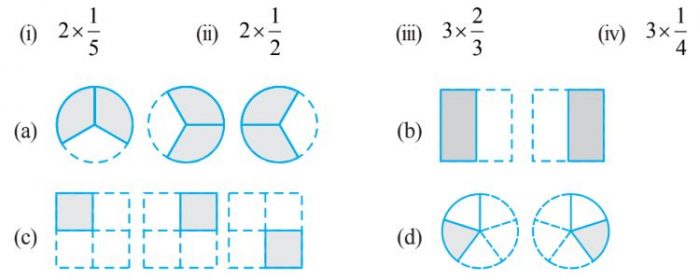



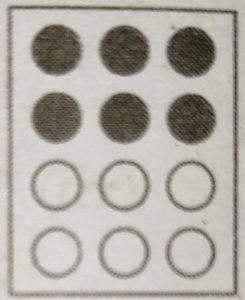
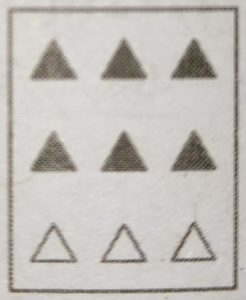
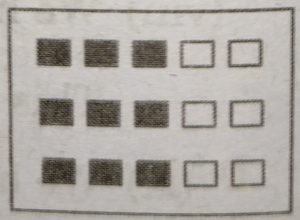

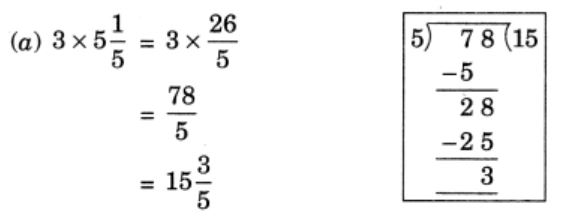
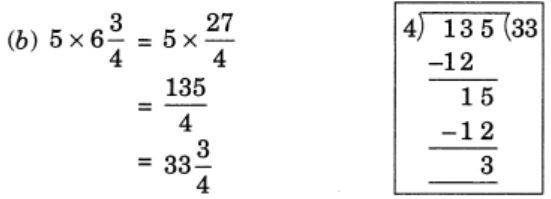
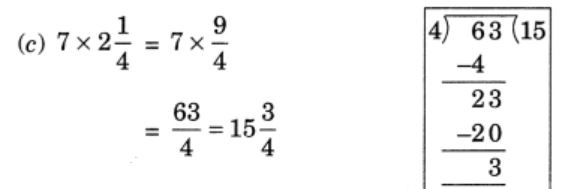

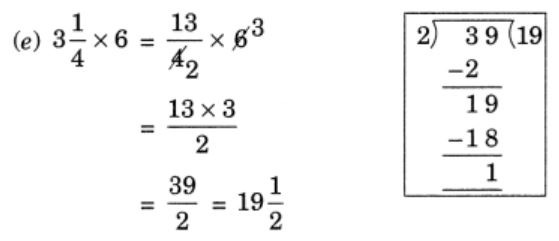



Leave a Reply